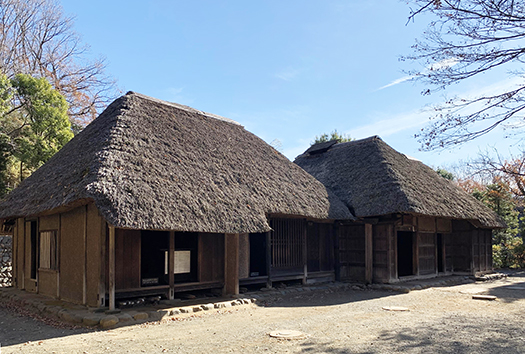

古民家シリーズ「日本人のいい家」その26軒目、常陸旧太田家住宅です。
創建は1600年代後期までさかのぼる古民家とのこと。築300年以上。
・・・なんですが、きょうはこの家に遺されていた江戸時代最後期の
「高札」遺物について考えてみたいと思います。
現代社会は「情報化社会」であって、当たり前のように世界と日本の出来事が
瞬時に多くのひとに知られる。そのことが前提になっている社会ですが、
それは高々150年ほど前の明治維新以降、近代国家として歩み始めてから
急速に進展してきたことであって、
それ以前の江戸期は「由らしむべし知らしむべからず」であり、
為政者は人民を施政に従わせればよいのであり、その道理を人民にわからせる必要はない
というのが基本的な情報へのスタンスだったと言えるでしょう。
そういう社会から明治への移行期、新政府の考え方を民衆に知らせたのが
この「五榜の掲示」という「高札」だったとされている。
いまの茨城県笠間市近郊に住んでいた太田家はムラ社会の庄屋として
新政府側から支給されたこの高札をムラの要地に掲げたものと思います。
定
一 人タルモノ五倫ノ道󠄁ヲ正シクスヘキ事
一 鰥寡孤獨癈疾ノモノヲ憫ムヘキ事
一 人ヲ殺󠄀シ家ヲ燒キ財ヲ盜ム等ノ惡業アル間敷󠄁事
慶應四年三月󠄁 太政官
というように読み下せる内容が、民への戒めとして告示されていた。
行政側の末端という庄屋としての立場から、伝達する意を持っていたのか、
この家ではこの高札を大切に保存してきた。
この五榜の掲示は全部で5枚の告諭があったのですが、
たぶん最初の人倫を説いたこの高札が普遍的内容と受け止め
家宝のように保存されてきたものでしょうか。
慶応4年3月というのは1868年3月であり、徳川からの政権交代直後。
新政府の施政方針を、民にわかりやすく説明する意図か。
五箇条の御誓文は支配階級向けの政治方針であり、
この五榜の掲示はいわば「マスメディア」の役割を担わせたというもの。
「鰥」とは61歳以上のやもめ(妻を亡くした夫)
「寡」とは50歳以上の未亡人
「孤(惸)」とは16歳以下の父親のいない子供
「独」は61歳以上の子供がいない者を指した。
「癈疾」は身体が不自由な人のこと。
カンカコドクハイシツというように読むのだそうです。
今日的には「福祉政策」の基本の考え方を開示したものと言えそうですが、
こういった方針自体は江戸幕府の基本を受け継いでいるもの。
むしろ、こういった基本はこれからも変わることはないよと、衆知させた。
この五榜の掲示以降、いろいろなメディアが創設されていって
高札での衆知というスタイルは消え去っていったとされています。
そういう意味では「広く情報を伝える」手段の革命期の記念碑ともいえる。
現代われわれは、新聞などのメディアからインターネットに軸足が移ってきている。
150年前ほどにこういう大転換があったということから、
温故知新すべきこともあるかも知れないと感じております。
English version⬇
[Media Revolution, Last Kosatsu “Posting of the Five Public Notifications”]
The 26th old folk house series “Good Japanese House”, the former Ota family house in Hitachi.
It was built as an old folk house dating back to the late 1600s. Over 300 years old.
… I mean, today was the last day of the Edo period that was left in this house.
I would like to think about “Kosatsu” relics.
The modern society is an “information society”, and the events of the world and Japan are commonplace.
Instantly known to many people. That is the premise of society,
It has been a modern nation since the Meiji Restoration at most 150 years ago.
It ’s a rapid progress,
Before that, the Edo period was “Yurashimubeshi Shimubezu”,
The politician only has to make the people obey the administration, and it is not necessary for the people to understand the reason.
It can be said that it was a stance on basic information.
During the transition from such a society to the Meiji era, it was what made the people aware of the new government’s thinking.
It is said that it was a “kosatsu” called “the bulletin board of the Five Public Notifications”.
The Ota family, who lived in the suburbs of Kasama City, Ibaraki Prefecture, is now a shoya in Mura society.
I think that this Kosatsu, which was provided by the new government, was put up at the key point of Mura.
Samadhi
One person Talmono Five Relationships 󠄁
I.
I. Killing people 󠄀 Shiya wo burning goods wo 盜, etc.
March, 4th year of Keio 󠄁 Daijo-kan
The content that can be read down was announced as a commandment to the people.
Did you intend to convey it from the standpoint of Shoya, the end of the administration?
This house has carefully preserved this kosatsu.
There were a total of 5 notices on this Five Public Notifications, but
Perhaps this Kosatsu, which preached the first humanity, is regarded as universal content
Is it preserved like a heirloom?
March 1868 is March 1868, immediately after the change of government from Tokugawa.
Is it the intention to explain the new government’s policy to the people in an easy-to-understand manner?
The Charter Oath is a political policy for the ruling class,
This bulletin board of the Five Public Notifications played the role of “mass media”.
“Husband” is a widow over 61 years old (husband who lost his wife)
“Widow” is a widow over 50 years old
“Solitary” is a child under the age of 16 without a father
“Germany” refers to those who have no children over the age of 61.
“Human” is a person with a physical disability.
It is said that it is read as “Kankakodokuhaishitsu”.
Today, it can be said that it disclosed the basic idea of ”welfare policy”.
These policies themselves inherit the basics of the Edo Shogunate.
Rather, he made people aware that these basics will not change in the future.
Since the posting of the Five Public Notifications, various media have been created.
It is said that the style of public knowledge on Kosatsu has disappeared.
In that sense, it can be said to be a monument to the revolutionary period of the means of “widely disseminating information.”
Today, we are shifting our focus from newspapers and other media to the Internet.
Since there was such a big change about 150 years ago,
I feel that there may be something that needs to be renewed.
Posted on 3月 17th, 2021 by 三木 奎吾
Filed under: 日本社会・文化研究, 歴史探訪







コメントを投稿
「※誹謗中傷や、悪意のある書き込み、営利目的などのコメントを防ぐために、投稿された全てのコメントは一時的に保留されますのでご了承ください。」
You must be logged in to post a comment.